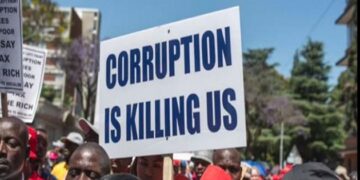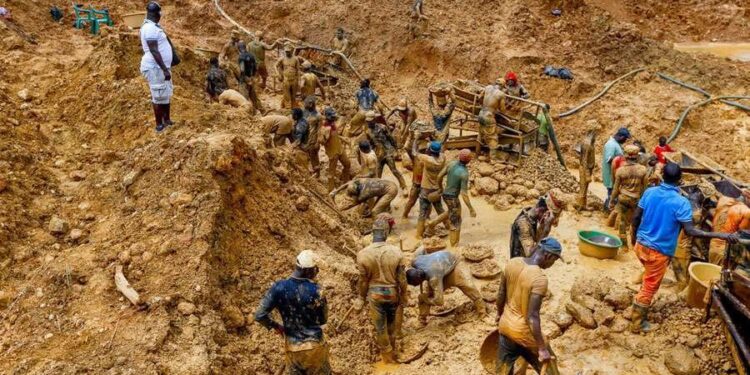Illegal mining, known locally in Ghana as galamsey, has for years been approached as a simple issue of poverty and unemployment, a problem thought to be solvable through alternative livelihood programs and stricter law enforcement (Abdulai et al., 2025; Eduful et al., 2020). However, this approach oversimplifies a deeply entrenched and multidimensional issue. In reality, galamsey is not merely a matter of illegal minning activity by some desperate individuals undertake to address poverty and locally related challenges; it is a complex socio-political and economic system, sustained by a network of actors, incentives, and informal arrangements that evolve dynamically over time (Asori et al., 2023; Teschner, 2012). To understand and address illegal mining in Ghana effectively, it is necessary to go beyond linear solutions and instead adopt a framework grounded in complexity theory and political economy. This dual lens allows us to recognise galamsey not as a technical issue of joblessness, but as a symptom of larger systemic failures, institutional weaknesses, and the economic rationality that drives both poor miners and powerful elites.
The mainstream response to galamsey has often centered on providing alternative livelihoods, under the assumption that miners engage in illegal mining simply because they lack other options (see Azumah, 2020; Mabe et al., 2021; Mensah, 2023). However, this line of thinking fails to grasp the scale of economic reward that illegal mining offers. A field survey by a CISA analyst in the western-north region of Ghana revealed that miners can earn anywhere from GHS 40000 to GHS 70000 per month, an income that far surpasses what most formal jobs or farming alternatives can provide. Suggesting that such individuals should trade this for soap making, tailoring among others with uncertain markets and poor returns is not just naive but economically unrealistic. Furthermore, this thinking rests on a flawed assumption of individual agency. Many miners are not acting alone, but as part of intricate patronage networks involving financiers, equipment suppliers, landowners, and political sponsors (Boafo et al., 2019; Bebbington et al., 2018).These actors often provide the capital and political cover necessary for mining operations to flourish, making the activity far more organised and protected than it appears on the surface. Therefore, framing galamsey as simply a poor man’s hustle ignores the broader economic and political ecosystem that sustains it. This is where complexity theory becomes an essential tool in understanding the galamsey phenomenon.
Complexity theory encourages us to view illegal mining as a dynamic and adaptive system composed of interconnected actors, feedback loops, and emergent behavior (Anderson, 1999; Turner & Baker, 2019).The problem of illegal mining cannot be reduced to simple cause-and-effect logic. For example, when the government bans excavators or deploys task forces to destroy mining sites, the result is not always compliance but adaptation: miners go underground, shift locations, or bribe local officials to continue operations. These unintended consequences are typical of non-linear systems, where small interventions can produce large ripple effects or simply fail due to the system’s ability to self-correct. Additionally, the field work by CISA analyst and additional report reveals that galamsey is sustained by feedback loops that reinforce its persistence such as rising gold prices that increase demand, political cycles that encourage lax enforcement before elections, or community dependence on mining revenue that discourages whistleblowing (see Lawal et al., 2025; Gyesaw, 2025; Yeboah, 2023). In this context, miners, financiers and even regulators are all adaptive agents who constantly adjust their behavior in response to changing circumstances, regulations, and incentives. The system evolves and mutates, making static solutions obsolete almost as soon as they are implemented.
Moreover, illegal mining must be understood as part of Ghana’s political economy. It is not merely the result of weak enforcement or lack of economic alternatives, but a rational outcome of how political and economic power is distributed and exercised. Politicians, especially during election seasons, often turn a blind eye to galamsey or directly benefit from it through campaign donations and support from local power brokers. Some MPs and district officials are known to have close ties with galamsey financiers, making them complicit in perpetuating the very system they are expected to dismantle. The field work also revealed that traditional authorities, too, sometimes lease out communal lands unofficially to miners in exchange for payments or “development contributions.” Security agencies and district assemblies, meant to enforce the law, are frequently compromised by bribes or political pressure. In such a context, galamsey is not a breakdown of the system, it is part of the system. It represents an informal governance structure where access to natural resources is mediated not just through state law, but through social networks, political loyalty as well as economic leverage.
Given this reality, the standard call to offer alternative livelihoods falls far short of the structural change needed. Instead of proposing simplistic economic substitutes for miners, we need to analyse the full ecosystem of illegal mining and intervene at multiple levels. This means developing what can be termed a “Galamsey Political Economy Model” rooted in complexity. Such a model begins with stakeholder mapping, identifying who benefits, who loses as well as how incentives are distributed across the system.
Rather than relying on top-down state interventions, we need adaptive governance models that bring together miners, chiefs, local officials, and community members to co-create rules, monitor activities, and resolve disputes, something similar to the recommendation of Elinor Ostrom. This participatory approach acknowledges that top-down enforcement alone will not work in areas where the state is either absent or mistrusted. Instead, co-regulation, transparency, and community accountability become vital tools (Herzberg, 2020; Fields, 1992).
To further shift the incentive structure, reforms must make legal small-scale mining more accessible, profitable,taxable and less bureaucratic. Many miners resort to illegality not because they want to, but because obtaining licenses is expensive, time-consuming, and plagued by corruption. Streamlining the legal mining process, providing technical support, and facilitating access to markets and capital could offer a more realistic path to formalization. At the same time, enforcement must go beyond targeting small-scale miners and begin addressing the financiers, equipment importers, and political actors who operate behind the scenes. Transparency in political funding, mining concessions, and land allocation is essential to dismantle the elite capture of the mining sector.
Furthermore, interventions must be flexible and experimental. Just as galamsey evolves, so too must the responses. Pilot programs in selected communities could test community licensing models, revenue-sharing agreements, or technological monitoring systems using GPS and drones. Instead of committing to one grand national solution, policymakers should treat interventions as experiments, learning from what works and scaling only those strategies that demonstrate genuine success. This requires both political will and institutional humility: a recognition that complex problems cannot be solved through rigid plans, but through ongoing engagement, feedback, and adaptation.
In conclusion, illegal mining in Ghana is not just an environmental or economic issue, it is a complex, adaptive, and politically entrenched system. As long as interventions remain locked in a mindset of linear causality, with the assumption that poverty causes mining, and mining creates jobs , the approach to solving the problem is doomed to fail. What is needed is a new approach grounded in the realities of complexity and political economy. This approach must be adaptive, inclusive, and dynamic, recognising that the solution to galamsey cannot be fixed in a blueprint but must evolve alongside the very system it seeks to transform.
References
Abdulai, A.-G., Buur, L., & Stacey, P. (2025). Party political campaigning and the illegal extraction of gold in Ghana. World Development, 192, 107008. https://doi.org/10.1016/j.worlddev.2025.107008
Anderson, P. (1999). Complexity Theory and Organization Science. Organization Science, 10(3), 216–232. http://www.jstor.org/stable/2640328
Asori, M., Mpobi, R. K. J., Morgan, A. K., Apoanaba, T. A., Katey, D., Ampofo, S. T., Julius, O., & Appiah, D. O. (2023). Is illegal mining socio-politically entrenched? An opinion piece of the interaction between formal politics and chief dominance in mineral governance, and its influence on fighting Galamsey in Ghana. GeoJournal, 88(2), 1953–1963. https://doi.org/10.1007/s10708-022-10725-1
Azumah, F. D., Baah, E., & Nachinaab, J. O. (2020). Causes and Effects of Illegal Gold Mining (Galamsey) Activities on School Dropout and Residents at the Tutuka Central Circuit in Obuasi Municipality in Ashanti Region, Ghana. Journal of Education, 201(3), 162-173. https://doi.org/10.1177/0022057420905109
Bebbington, A., Abdulai, A.-G., Bebbington, D. H., Hinfelaar, M., Sanborn, C. A., Achberger, J., Huber, C. G., Hurtado, V., Ramírez, T., & Odell, S. D. (2018). Competitive Clientelism and the Political Economy of Mining in Ghana. Governing Extractive Industries, 152-196. https://doi.org/10.1093/oso/9780198820932.003.0005
Boafo, J., Paalo, S., & Dotsey, S. (2019). Illicit Chinese Small-Scale Mining in Ghana: Beyond Institutional Weakness?. Sustainability, 11(21), 5943. https://doi.org/10.3390/su11215943
Eduful, M., Alsharif, K., Eduful, A., Acheampong, M., Eduful, J., & Mazumder, L. (2020). The Illegal Artisanal and Small-scale mining (Galamsey) ‘Menace’ in Ghana: Is Military-Style Approach the Answer?. Resources Policy, 68, 101732. https://doi.org/10.1016/j.resourpol.2020.101732
Field, B. C. (1992). [Review of Governing the Commons: The Evolution of Institutions for Collective Action, by E. Ostrom]. Land Economics, 68(3), 354–357. https://doi.org/10.2307/3146384
Herzberg, R. Q. (2020). Elinor Ostrom’s Governing the Commons: Institutional Diversity, Self-Governance, and Tragedy Diverted. The Independent Review, 24(4), 627–636. https://www.jstor.org/stable/48583528
Mabe, F. N., Owusu-Sekyere, E., & Adeosun, O. T. (2021). Livelihood coping strategies among displaced small scale miners in Ghana. Resources Policy, 74, 102291. https://doi.org/10.1016/j.resourpol.2021.102291
Mensah , A. K. (2023). Alternative Livelihood Programs In Solving Galamsey: Will The .. www.modernghana.com. June 18, 2025. https://www.modernghana.com/news/1234874/alternative-livelihood-programs-in-solving-galamse.html
Teschner, B. A. (2012). Small-scale mining in Ghana: The government and the galamsey. Resources Policy, 37(3), 308-314. https://doi.org/10.1016/j.resourpol.2012.02.001






























